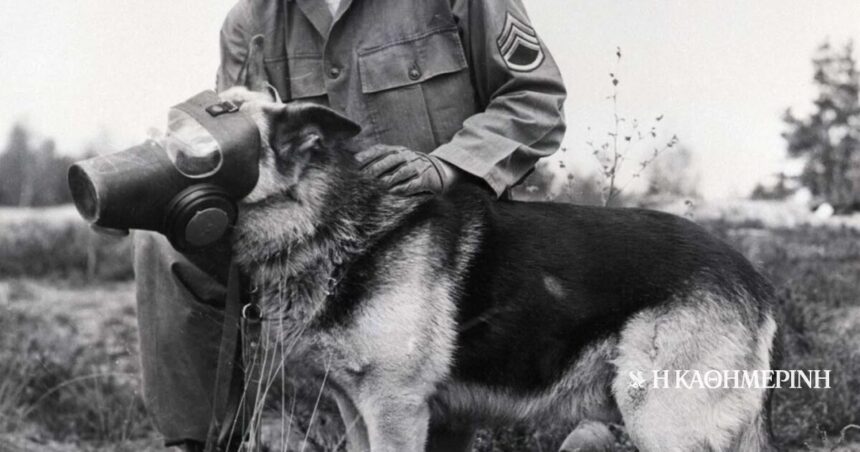“Goodbye to the war! This is all I’ve been thinking about since this morning. Well we humans. We have our interests, our ideologies, our quirks, our bigotry and our enthusiasms. War is famously cooked from all this. We also have our tricks, to escape when we see the zorikas. Our home, the hospitals, even the deserts. But the goods that we enlist to make war with us? I daresay that, when people sometimes get out of themselves the epilepsy of mass murder, they will have every right to be ashamed for the rest of their lives and only for this: that they also dragged innocent people into the war. I think that one day it will be one of the blackest marks in the History of Humans”, wrote Stratis Myrivilis in his novel “Life in the grave”. Its pages depict the horror of World War I (1914-1918), one of the deadliest conflicts in history, in which more than fifty (according to a conservative estimate) people, soldiers and civilians, lost their lives, but also almost ten million animals, mostly equids, found on the battlefields; never before had so many, mostly equids, been used in a warlike conflict. Only 60,000 returned to their stables.
Around 20,000 dogs were used in World War I. They carried equipment and messages and provided valuable services in helping to find survivors. At the Battle of Verdun in northeastern France, for example, Satan, as he was called, a black border collie, saved the French garrison from being besieged by the Germans because he delivered a warning message in time, even though he was wounded. One of the most courageous fighting dogs was Stubby. He began his life as a stray and, after special training, followed the American troops to Europe. He participated in seventeen battles, thanks to his sense of smell he saved his company from a surprise enemy chemical gas attack, and when he returned to the United States he was greeted as a hero! He was adopted by an officer and died peacefully in his sleep in the spring of 1926… The role of thousands of carrier pigeons in carrying messages and photographing enemy installations was also pivotal.



In World War II, animal losses were also huge, estimated at five million: the most numerous were equids – horses, donkeys and mules -, but also dogs. They were killed by enemy fire, others drowned in the mud on the battlefields or died exhausted, loaded with ammunition and supplies. Or they experienced horror as weapons in the hands of humans, like the suicide dogs used by the US military. They were trained to run towards enemy tanks, carrying explosive devices, which the soldiers would detonate at the right moment. And, of course, the number of animals of the Old Continent, domestic and productive, that died from bombardment, starvation and hardship will remain forever unknown.
In 1940, the Greek army had 130,000 horses, some purchased, but the vast majority were requisitioned. On the Albanian front, in extremely adverse conditions in which the Italians’ state-of-the-art motorized vehicles could not move, these horses, mules and donkeys became a decisive factor in victory. They barely survived. The testimony of a soldier is shocking, as it was conveyed a few years ago by the chief physician, colonel Konstantinos Terpsidis, in his tribute to the only units (horses, horses, half-horses) of our army: “In a ditch, covered with snow, the Fisherman stuck to me. Hungry, drenched to the bone, exhausted from the incessant running on the rocks he was meant to stay there. I caressed its neck a little and kissed it. And I moved. In a few steps I turned to look at it one last time. He may have been an animal, but he was a companion in war. We had seen death so many times together, we had spent together days and nights of life such that they are never forgotten. And I saw it looking at me as I was leaving. What a look that was… How plaintive, how sorrowful it was. I started crying. But the war leaves no time for such things. At one point I thought of killing it. My heart couldn’t take it and I left it there. He was looking at me until I disappeared behind the rock”…



Instead of a postscript
“They had no choice.” These words will be read at the base of the monument located in the center of London, in Hyde Park, and with which Great Britain honored the animals killed during the great wars in Europe. Similar monuments exist in France and other European countries. But not ours… We owe a “thank you” to these animals, then, as well as to those who helped the country, in time of peace, to stand on its feet again. At the beginning of the 1950s, ships with mules from the USA began to arrive in our country (“semi-healthy and suitable for the Greek climate”, as the newspapers wrote), in the context of the Marshall Plan for the restoration of productive activity. These put their backs, literally, on the reconstruction of Greece.




